MGT5STR: Strategic Management Analysis of NESTLE Corporation
VerifiedAdded on 2023/06/13
|26
|8252
|297
Report
AI Summary
This report provides a strategic management analysis of NESTLE Company, examining its business units, sources of sustainable competitive advantage, diversification strategies, and revenue centers. The analysis includes internal and external factors, such as strengths, weaknesses, opportunities, and threats (SWOT), as well as political, economic, social, technological, environmental, and legal (PESTLE) factors affecting NESTLE's business units. The report identifies key revenue-generating units like L’Oreal, Nestle Snow with Snow Brand Milk Products, and Nestle Modelo with Grupo Modelo, highlighting their contributions to NESTLE's overall revenue. It also discusses NESTLE's market development strategy, product differentiation, and cost leadership approaches in various regions, particularly in Asian countries. The report concludes with recommendations for future business planning, emphasizing product development and market expansion strategies to enhance NESTLE's competitive position.
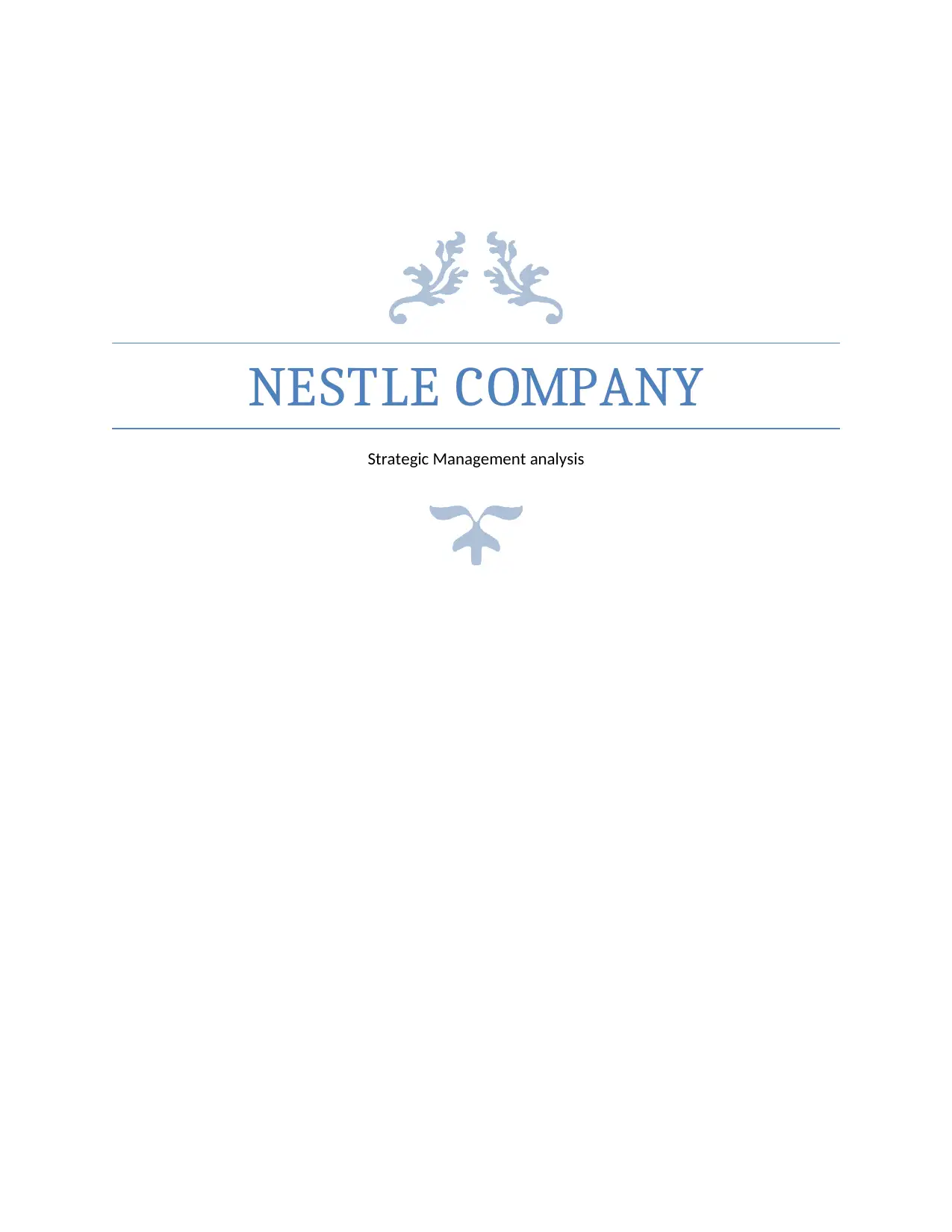
NESTLE COMPANY
Strategic Management analysis
Strategic Management analysis
Paraphrase This Document
Need a fresh take? Get an instant paraphrase of this document with our AI Paraphraser
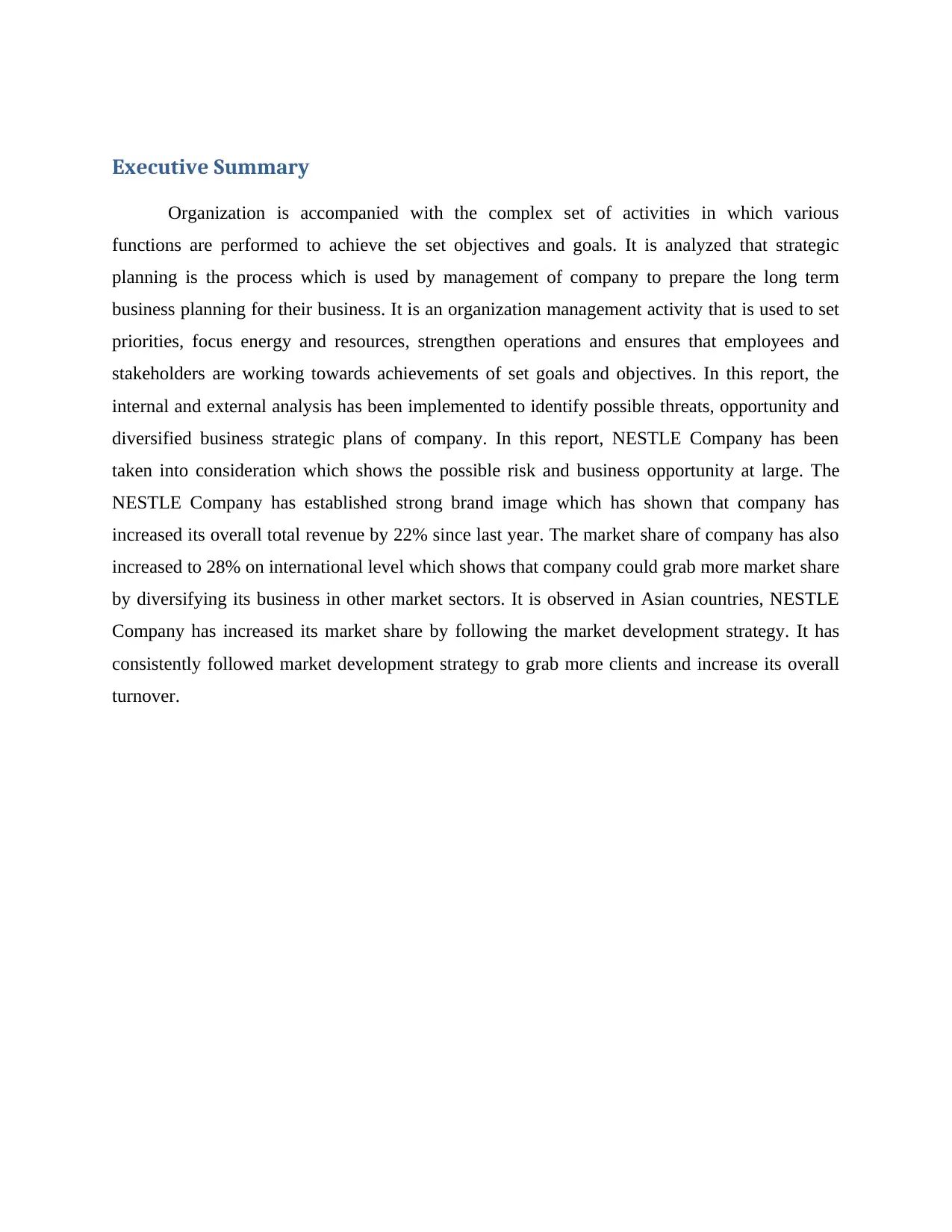
Executive Summary
Organization is accompanied with the complex set of activities in which various
functions are performed to achieve the set objectives and goals. It is analyzed that strategic
planning is the process which is used by management of company to prepare the long term
business planning for their business. It is an organization management activity that is used to set
priorities, focus energy and resources, strengthen operations and ensures that employees and
stakeholders are working towards achievements of set goals and objectives. In this report, the
internal and external analysis has been implemented to identify possible threats, opportunity and
diversified business strategic plans of company. In this report, NESTLE Company has been
taken into consideration which shows the possible risk and business opportunity at large. The
NESTLE Company has established strong brand image which has shown that company has
increased its overall total revenue by 22% since last year. The market share of company has also
increased to 28% on international level which shows that company could grab more market share
by diversifying its business in other market sectors. It is observed in Asian countries, NESTLE
Company has increased its market share by following the market development strategy. It has
consistently followed market development strategy to grab more clients and increase its overall
turnover.
Organization is accompanied with the complex set of activities in which various
functions are performed to achieve the set objectives and goals. It is analyzed that strategic
planning is the process which is used by management of company to prepare the long term
business planning for their business. It is an organization management activity that is used to set
priorities, focus energy and resources, strengthen operations and ensures that employees and
stakeholders are working towards achievements of set goals and objectives. In this report, the
internal and external analysis has been implemented to identify possible threats, opportunity and
diversified business strategic plans of company. In this report, NESTLE Company has been
taken into consideration which shows the possible risk and business opportunity at large. The
NESTLE Company has established strong brand image which has shown that company has
increased its overall total revenue by 22% since last year. The market share of company has also
increased to 28% on international level which shows that company could grab more market share
by diversifying its business in other market sectors. It is observed in Asian countries, NESTLE
Company has increased its market share by following the market development strategy. It has
consistently followed market development strategy to grab more clients and increase its overall
turnover.
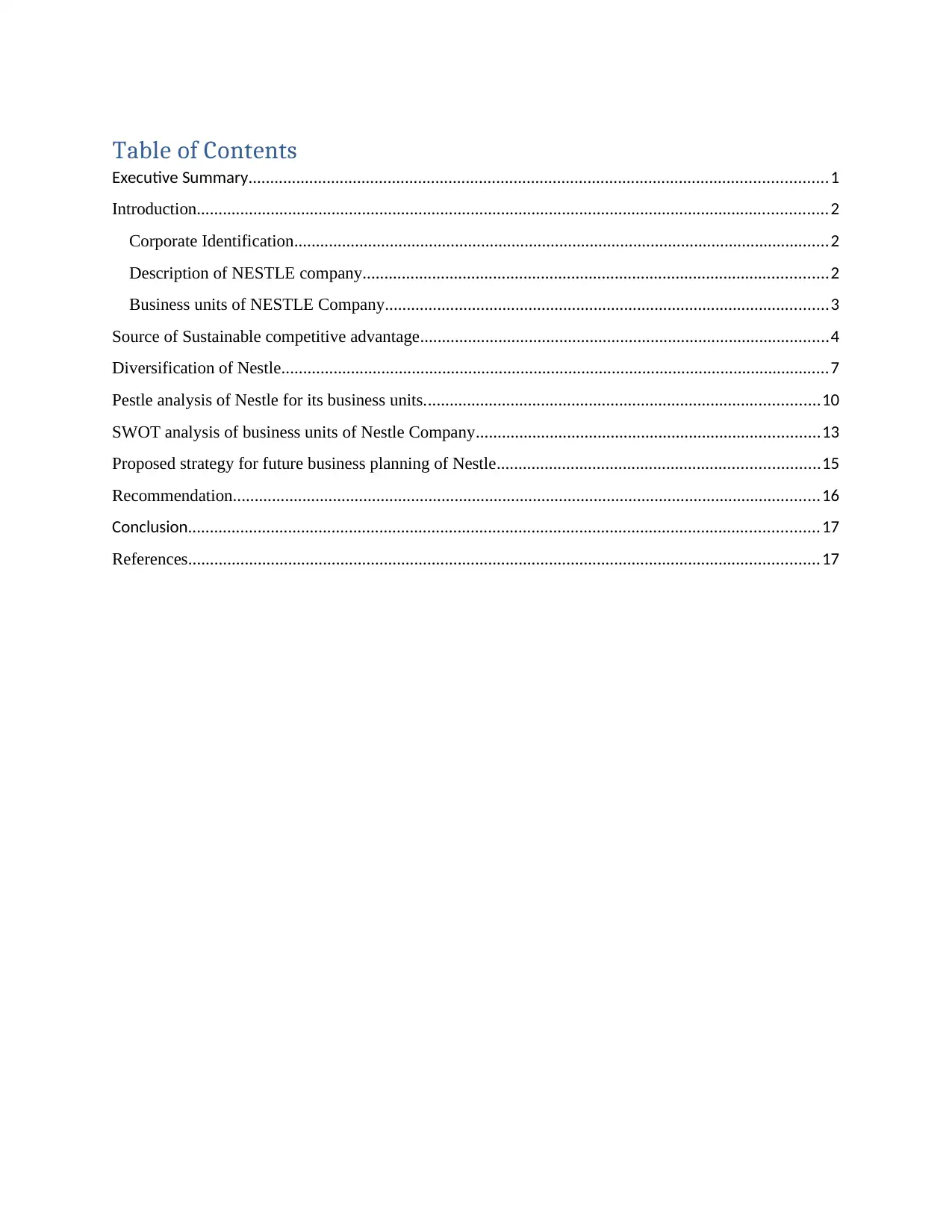
Table of Contents
Executive Summary.....................................................................................................................................1
Introduction.................................................................................................................................................2
Corporate Identification...........................................................................................................................2
Description of NESTLE company...........................................................................................................2
Business units of NESTLE Company......................................................................................................3
Source of Sustainable competitive advantage..............................................................................................4
Diversification of Nestle..............................................................................................................................7
Pestle analysis of Nestle for its business units...........................................................................................10
SWOT analysis of business units of Nestle Company...............................................................................13
Proposed strategy for future business planning of Nestle..........................................................................15
Recommendation.......................................................................................................................................16
Conclusion.................................................................................................................................................17
References.................................................................................................................................................17
Executive Summary.....................................................................................................................................1
Introduction.................................................................................................................................................2
Corporate Identification...........................................................................................................................2
Description of NESTLE company...........................................................................................................2
Business units of NESTLE Company......................................................................................................3
Source of Sustainable competitive advantage..............................................................................................4
Diversification of Nestle..............................................................................................................................7
Pestle analysis of Nestle for its business units...........................................................................................10
SWOT analysis of business units of Nestle Company...............................................................................13
Proposed strategy for future business planning of Nestle..........................................................................15
Recommendation.......................................................................................................................................16
Conclusion.................................................................................................................................................17
References.................................................................................................................................................17
⊘ This is a preview!⊘
Do you want full access?
Subscribe today to unlock all pages.

Trusted by 1+ million students worldwide
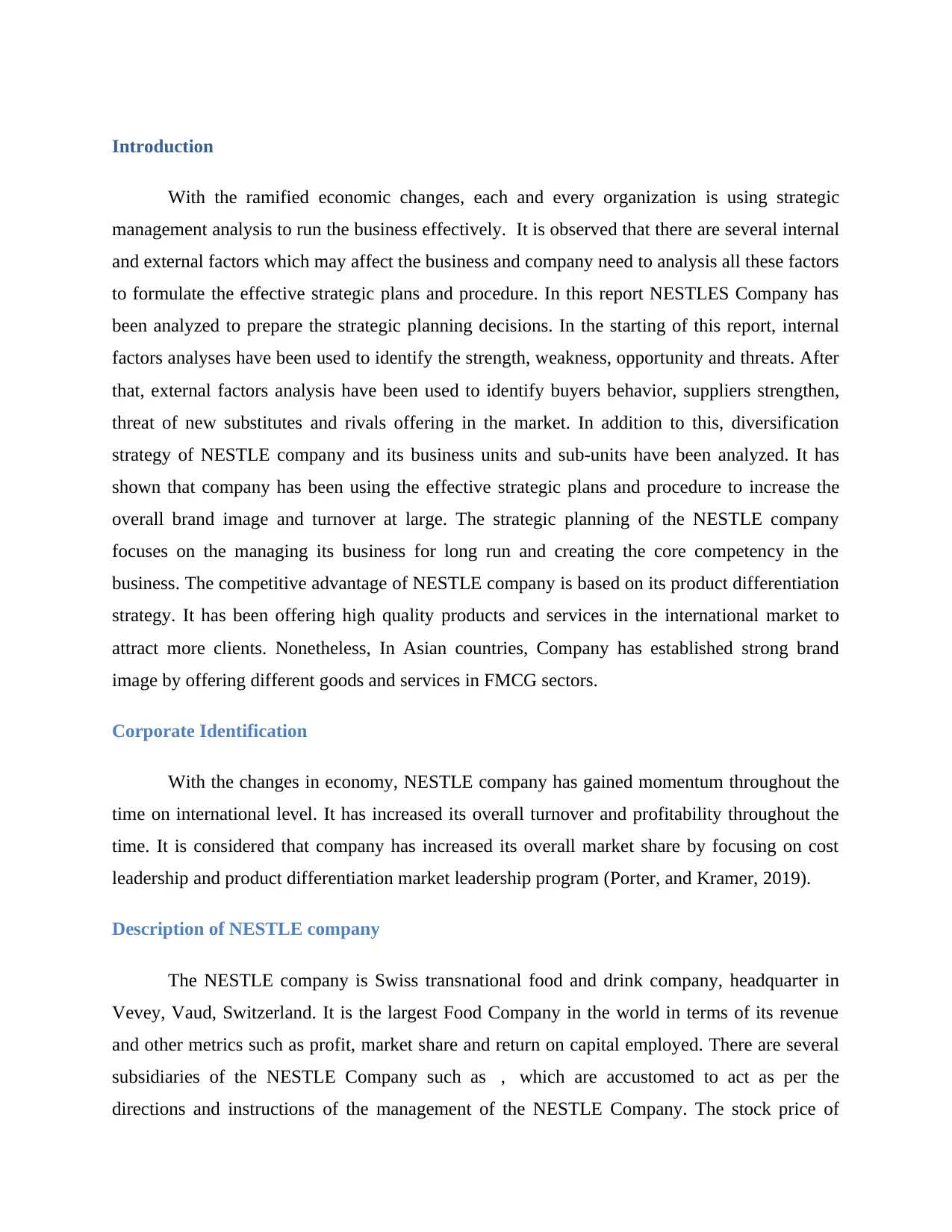
Introduction
With the ramified economic changes, each and every organization is using strategic
management analysis to run the business effectively. It is observed that there are several internal
and external factors which may affect the business and company need to analysis all these factors
to formulate the effective strategic plans and procedure. In this report NESTLES Company has
been analyzed to prepare the strategic planning decisions. In the starting of this report, internal
factors analyses have been used to identify the strength, weakness, opportunity and threats. After
that, external factors analysis have been used to identify buyers behavior, suppliers strengthen,
threat of new substitutes and rivals offering in the market. In addition to this, diversification
strategy of NESTLE company and its business units and sub-units have been analyzed. It has
shown that company has been using the effective strategic plans and procedure to increase the
overall brand image and turnover at large. The strategic planning of the NESTLE company
focuses on the managing its business for long run and creating the core competency in the
business. The competitive advantage of NESTLE company is based on its product differentiation
strategy. It has been offering high quality products and services in the international market to
attract more clients. Nonetheless, In Asian countries, Company has established strong brand
image by offering different goods and services in FMCG sectors.
Corporate Identification
With the changes in economy, NESTLE company has gained momentum throughout the
time on international level. It has increased its overall turnover and profitability throughout the
time. It is considered that company has increased its overall market share by focusing on cost
leadership and product differentiation market leadership program (Porter, and Kramer, 2019).
Description of NESTLE company
The NESTLE company is Swiss transnational food and drink company, headquarter in
Vevey, Vaud, Switzerland. It is the largest Food Company in the world in terms of its revenue
and other metrics such as profit, market share and return on capital employed. There are several
subsidiaries of the NESTLE Company such as , which are accustomed to act as per the
directions and instructions of the management of the NESTLE Company. The stock price of
With the ramified economic changes, each and every organization is using strategic
management analysis to run the business effectively. It is observed that there are several internal
and external factors which may affect the business and company need to analysis all these factors
to formulate the effective strategic plans and procedure. In this report NESTLES Company has
been analyzed to prepare the strategic planning decisions. In the starting of this report, internal
factors analyses have been used to identify the strength, weakness, opportunity and threats. After
that, external factors analysis have been used to identify buyers behavior, suppliers strengthen,
threat of new substitutes and rivals offering in the market. In addition to this, diversification
strategy of NESTLE company and its business units and sub-units have been analyzed. It has
shown that company has been using the effective strategic plans and procedure to increase the
overall brand image and turnover at large. The strategic planning of the NESTLE company
focuses on the managing its business for long run and creating the core competency in the
business. The competitive advantage of NESTLE company is based on its product differentiation
strategy. It has been offering high quality products and services in the international market to
attract more clients. Nonetheless, In Asian countries, Company has established strong brand
image by offering different goods and services in FMCG sectors.
Corporate Identification
With the changes in economy, NESTLE company has gained momentum throughout the
time on international level. It has increased its overall turnover and profitability throughout the
time. It is considered that company has increased its overall market share by focusing on cost
leadership and product differentiation market leadership program (Porter, and Kramer, 2019).
Description of NESTLE company
The NESTLE company is Swiss transnational food and drink company, headquarter in
Vevey, Vaud, Switzerland. It is the largest Food Company in the world in terms of its revenue
and other metrics such as profit, market share and return on capital employed. There are several
subsidiaries of the NESTLE Company such as , which are accustomed to act as per the
directions and instructions of the management of the NESTLE Company. The stock price of
Paraphrase This Document
Need a fresh take? Get an instant paraphrase of this document with our AI Paraphraser
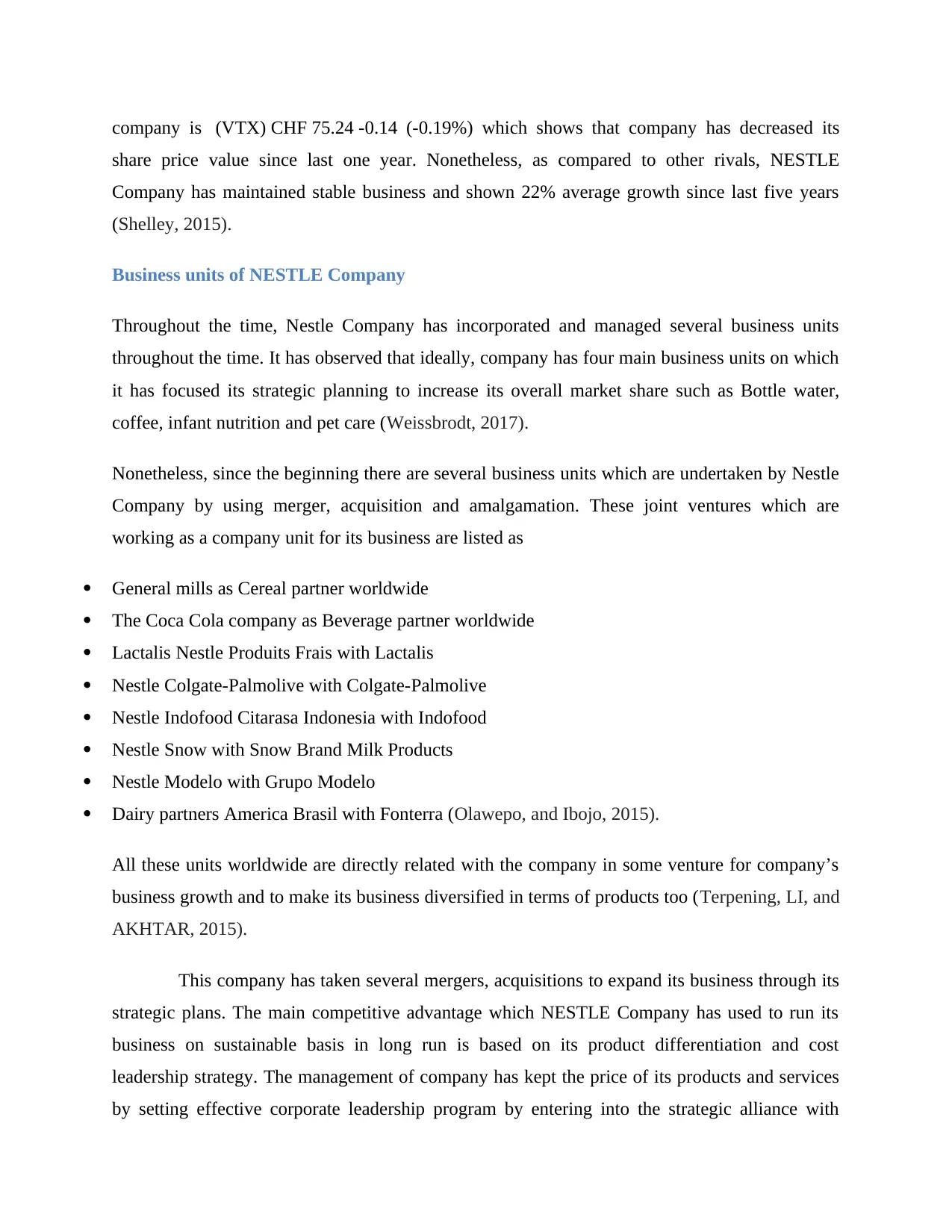
company is (VTX) CHF 75.24 -0.14 (-0.19%) which shows that company has decreased its
share price value since last one year. Nonetheless, as compared to other rivals, NESTLE
Company has maintained stable business and shown 22% average growth since last five years
(Shelley, 2015).
Business units of NESTLE Company
Throughout the time, Nestle Company has incorporated and managed several business units
throughout the time. It has observed that ideally, company has four main business units on which
it has focused its strategic planning to increase its overall market share such as Bottle water,
coffee, infant nutrition and pet care (Weissbrodt, 2017).
Nonetheless, since the beginning there are several business units which are undertaken by Nestle
Company by using merger, acquisition and amalgamation. These joint ventures which are
working as a company unit for its business are listed as
General mills as Cereal partner worldwide
The Coca Cola company as Beverage partner worldwide
Lactalis Nestle Produits Frais with Lactalis
Nestle Colgate-Palmolive with Colgate-Palmolive
Nestle Indofood Citarasa Indonesia with Indofood
Nestle Snow with Snow Brand Milk Products
Nestle Modelo with Grupo Modelo
Dairy partners America Brasil with Fonterra (Olawepo, and Ibojo, 2015).
All these units worldwide are directly related with the company in some venture for company’s
business growth and to make its business diversified in terms of products too (Terpening, LI, and
AKHTAR, 2015).
This company has taken several mergers, acquisitions to expand its business through its
strategic plans. The main competitive advantage which NESTLE Company has used to run its
business on sustainable basis in long run is based on its product differentiation and cost
leadership strategy. The management of company has kept the price of its products and services
by setting effective corporate leadership program by entering into the strategic alliance with
share price value since last one year. Nonetheless, as compared to other rivals, NESTLE
Company has maintained stable business and shown 22% average growth since last five years
(Shelley, 2015).
Business units of NESTLE Company
Throughout the time, Nestle Company has incorporated and managed several business units
throughout the time. It has observed that ideally, company has four main business units on which
it has focused its strategic planning to increase its overall market share such as Bottle water,
coffee, infant nutrition and pet care (Weissbrodt, 2017).
Nonetheless, since the beginning there are several business units which are undertaken by Nestle
Company by using merger, acquisition and amalgamation. These joint ventures which are
working as a company unit for its business are listed as
General mills as Cereal partner worldwide
The Coca Cola company as Beverage partner worldwide
Lactalis Nestle Produits Frais with Lactalis
Nestle Colgate-Palmolive with Colgate-Palmolive
Nestle Indofood Citarasa Indonesia with Indofood
Nestle Snow with Snow Brand Milk Products
Nestle Modelo with Grupo Modelo
Dairy partners America Brasil with Fonterra (Olawepo, and Ibojo, 2015).
All these units worldwide are directly related with the company in some venture for company’s
business growth and to make its business diversified in terms of products too (Terpening, LI, and
AKHTAR, 2015).
This company has taken several mergers, acquisitions to expand its business through its
strategic plans. The main competitive advantage which NESTLE Company has used to run its
business on sustainable basis in long run is based on its product differentiation and cost
leadership strategy. The management of company has kept the price of its products and services
by setting effective corporate leadership program by entering into the strategic alliance with
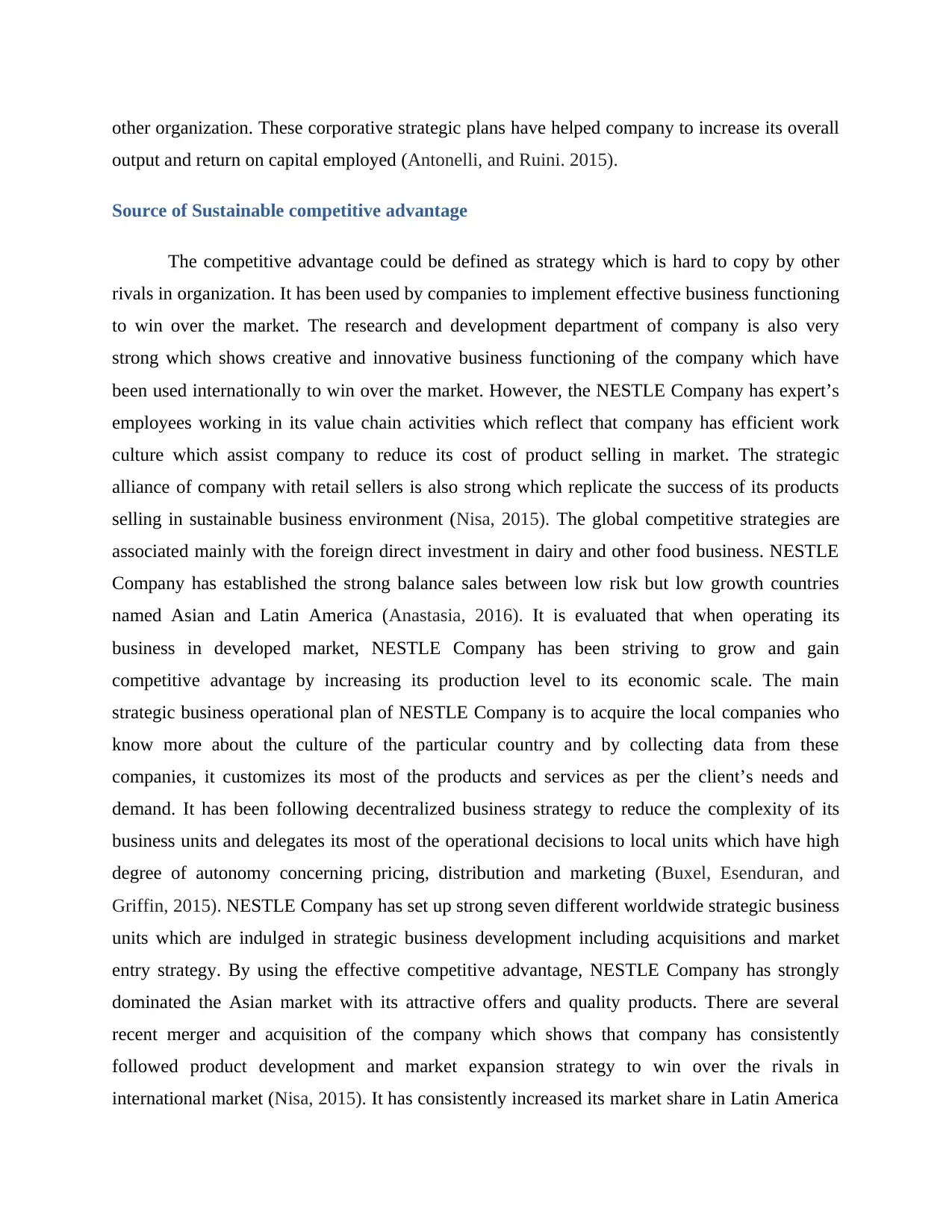
other organization. These corporative strategic plans have helped company to increase its overall
output and return on capital employed (Antonelli, and Ruini. 2015).
Source of Sustainable competitive advantage
The competitive advantage could be defined as strategy which is hard to copy by other
rivals in organization. It has been used by companies to implement effective business functioning
to win over the market. The research and development department of company is also very
strong which shows creative and innovative business functioning of the company which have
been used internationally to win over the market. However, the NESTLE Company has expert’s
employees working in its value chain activities which reflect that company has efficient work
culture which assist company to reduce its cost of product selling in market. The strategic
alliance of company with retail sellers is also strong which replicate the success of its products
selling in sustainable business environment (Nisa, 2015). The global competitive strategies are
associated mainly with the foreign direct investment in dairy and other food business. NESTLE
Company has established the strong balance sales between low risk but low growth countries
named Asian and Latin America (Anastasia, 2016). It is evaluated that when operating its
business in developed market, NESTLE Company has been striving to grow and gain
competitive advantage by increasing its production level to its economic scale. The main
strategic business operational plan of NESTLE Company is to acquire the local companies who
know more about the culture of the particular country and by collecting data from these
companies, it customizes its most of the products and services as per the client’s needs and
demand. It has been following decentralized business strategy to reduce the complexity of its
business units and delegates its most of the operational decisions to local units which have high
degree of autonomy concerning pricing, distribution and marketing (Buxel, Esenduran, and
Griffin, 2015). NESTLE Company has set up strong seven different worldwide strategic business
units which are indulged in strategic business development including acquisitions and market
entry strategy. By using the effective competitive advantage, NESTLE Company has strongly
dominated the Asian market with its attractive offers and quality products. There are several
recent merger and acquisition of the company which shows that company has consistently
followed product development and market expansion strategy to win over the rivals in
international market (Nisa, 2015). It has consistently increased its market share in Latin America
output and return on capital employed (Antonelli, and Ruini. 2015).
Source of Sustainable competitive advantage
The competitive advantage could be defined as strategy which is hard to copy by other
rivals in organization. It has been used by companies to implement effective business functioning
to win over the market. The research and development department of company is also very
strong which shows creative and innovative business functioning of the company which have
been used internationally to win over the market. However, the NESTLE Company has expert’s
employees working in its value chain activities which reflect that company has efficient work
culture which assist company to reduce its cost of product selling in market. The strategic
alliance of company with retail sellers is also strong which replicate the success of its products
selling in sustainable business environment (Nisa, 2015). The global competitive strategies are
associated mainly with the foreign direct investment in dairy and other food business. NESTLE
Company has established the strong balance sales between low risk but low growth countries
named Asian and Latin America (Anastasia, 2016). It is evaluated that when operating its
business in developed market, NESTLE Company has been striving to grow and gain
competitive advantage by increasing its production level to its economic scale. The main
strategic business operational plan of NESTLE Company is to acquire the local companies who
know more about the culture of the particular country and by collecting data from these
companies, it customizes its most of the products and services as per the client’s needs and
demand. It has been following decentralized business strategy to reduce the complexity of its
business units and delegates its most of the operational decisions to local units which have high
degree of autonomy concerning pricing, distribution and marketing (Buxel, Esenduran, and
Griffin, 2015). NESTLE Company has set up strong seven different worldwide strategic business
units which are indulged in strategic business development including acquisitions and market
entry strategy. By using the effective competitive advantage, NESTLE Company has strongly
dominated the Asian market with its attractive offers and quality products. There are several
recent merger and acquisition of the company which shows that company has consistently
followed product development and market expansion strategy to win over the rivals in
international market (Nisa, 2015). It has consistently increased its market share in Latin America
⊘ This is a preview!⊘
Do you want full access?
Subscribe today to unlock all pages.

Trusted by 1+ million students worldwide
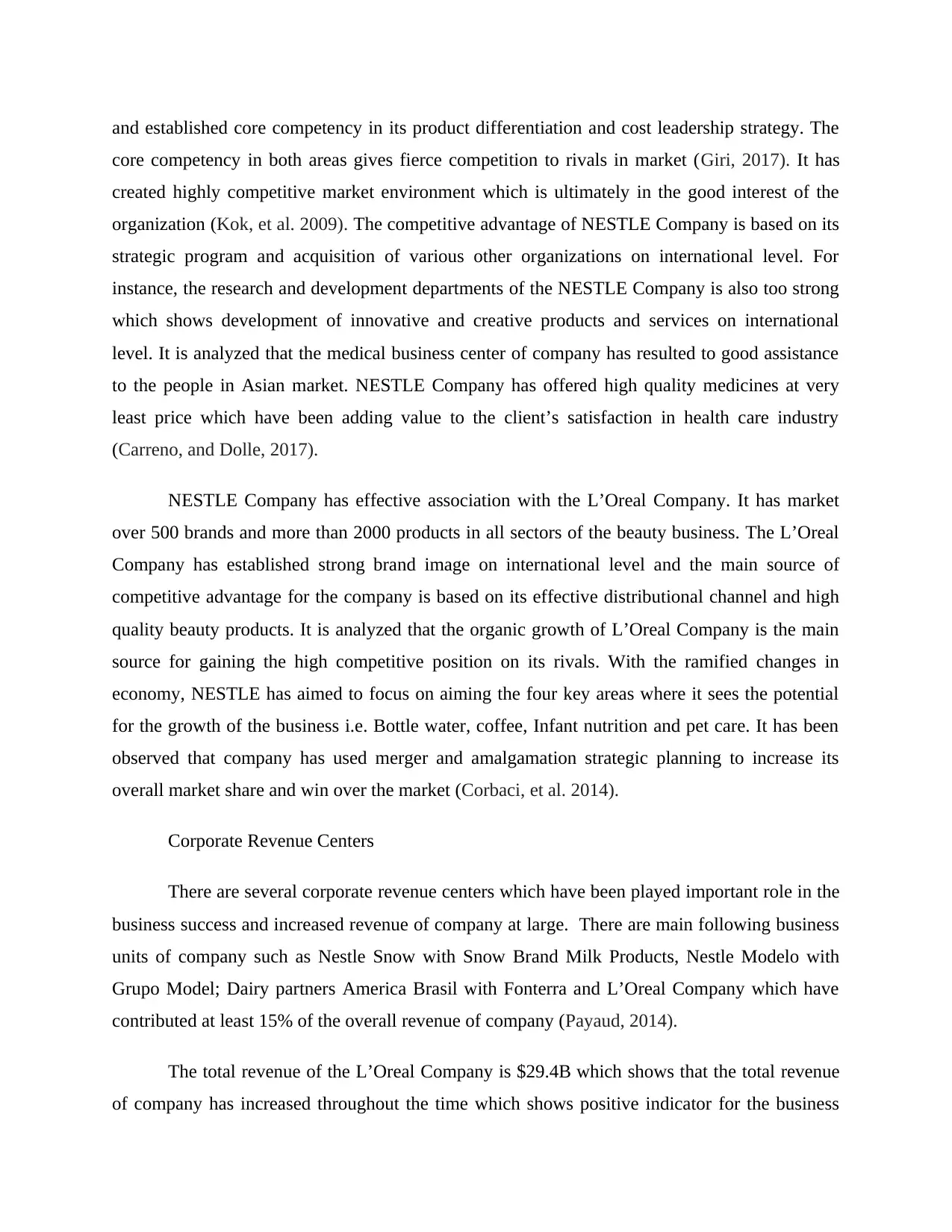
and established core competency in its product differentiation and cost leadership strategy. The
core competency in both areas gives fierce competition to rivals in market (Giri, 2017). It has
created highly competitive market environment which is ultimately in the good interest of the
organization (Kok, et al. 2009). The competitive advantage of NESTLE Company is based on its
strategic program and acquisition of various other organizations on international level. For
instance, the research and development departments of the NESTLE Company is also too strong
which shows development of innovative and creative products and services on international
level. It is analyzed that the medical business center of company has resulted to good assistance
to the people in Asian market. NESTLE Company has offered high quality medicines at very
least price which have been adding value to the client’s satisfaction in health care industry
(Carreno, and Dolle, 2017).
NESTLE Company has effective association with the L’Oreal Company. It has market
over 500 brands and more than 2000 products in all sectors of the beauty business. The L’Oreal
Company has established strong brand image on international level and the main source of
competitive advantage for the company is based on its effective distributional channel and high
quality beauty products. It is analyzed that the organic growth of L’Oreal Company is the main
source for gaining the high competitive position on its rivals. With the ramified changes in
economy, NESTLE has aimed to focus on aiming the four key areas where it sees the potential
for the growth of the business i.e. Bottle water, coffee, Infant nutrition and pet care. It has been
observed that company has used merger and amalgamation strategic planning to increase its
overall market share and win over the market (Corbaci, et al. 2014).
Corporate Revenue Centers
There are several corporate revenue centers which have been played important role in the
business success and increased revenue of company at large. There are main following business
units of company such as Nestle Snow with Snow Brand Milk Products, Nestle Modelo with
Grupo Model; Dairy partners America Brasil with Fonterra and L’Oreal Company which have
contributed at least 15% of the overall revenue of company (Payaud, 2014).
The total revenue of the L’Oreal Company is $29.4B which shows that the total revenue
of company has increased throughout the time which shows positive indicator for the business
core competency in both areas gives fierce competition to rivals in market (Giri, 2017). It has
created highly competitive market environment which is ultimately in the good interest of the
organization (Kok, et al. 2009). The competitive advantage of NESTLE Company is based on its
strategic program and acquisition of various other organizations on international level. For
instance, the research and development departments of the NESTLE Company is also too strong
which shows development of innovative and creative products and services on international
level. It is analyzed that the medical business center of company has resulted to good assistance
to the people in Asian market. NESTLE Company has offered high quality medicines at very
least price which have been adding value to the client’s satisfaction in health care industry
(Carreno, and Dolle, 2017).
NESTLE Company has effective association with the L’Oreal Company. It has market
over 500 brands and more than 2000 products in all sectors of the beauty business. The L’Oreal
Company has established strong brand image on international level and the main source of
competitive advantage for the company is based on its effective distributional channel and high
quality beauty products. It is analyzed that the organic growth of L’Oreal Company is the main
source for gaining the high competitive position on its rivals. With the ramified changes in
economy, NESTLE has aimed to focus on aiming the four key areas where it sees the potential
for the growth of the business i.e. Bottle water, coffee, Infant nutrition and pet care. It has been
observed that company has used merger and amalgamation strategic planning to increase its
overall market share and win over the market (Corbaci, et al. 2014).
Corporate Revenue Centers
There are several corporate revenue centers which have been played important role in the
business success and increased revenue of company at large. There are main following business
units of company such as Nestle Snow with Snow Brand Milk Products, Nestle Modelo with
Grupo Model; Dairy partners America Brasil with Fonterra and L’Oreal Company which have
contributed at least 15% of the overall revenue of company (Payaud, 2014).
The total revenue of the L’Oreal Company is $29.4B which shows that the total revenue
of company has increased throughout the time which shows positive indicator for the business
Paraphrase This Document
Need a fresh take? Get an instant paraphrase of this document with our AI Paraphraser
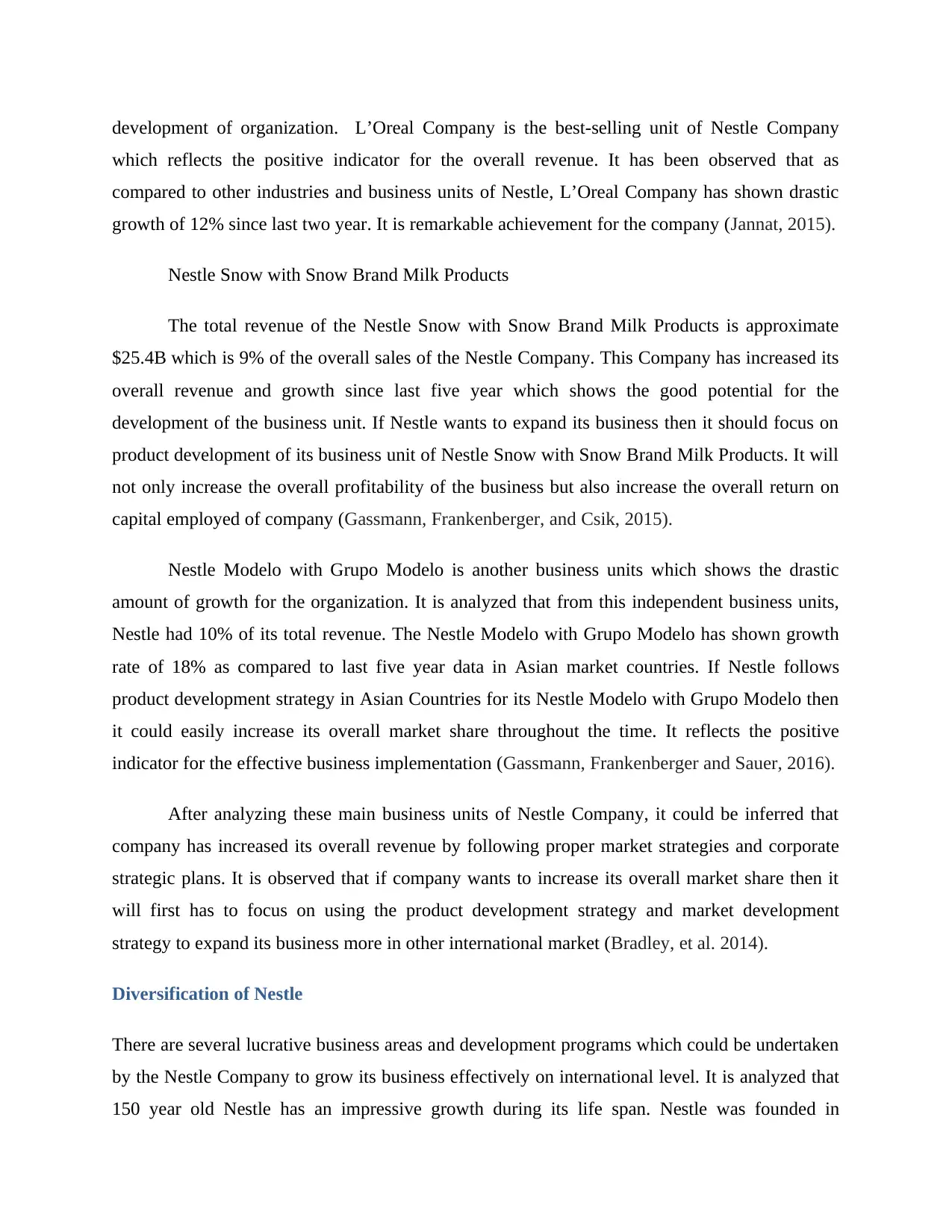
development of organization. L’Oreal Company is the best-selling unit of Nestle Company
which reflects the positive indicator for the overall revenue. It has been observed that as
compared to other industries and business units of Nestle, L’Oreal Company has shown drastic
growth of 12% since last two year. It is remarkable achievement for the company (Jannat, 2015).
Nestle Snow with Snow Brand Milk Products
The total revenue of the Nestle Snow with Snow Brand Milk Products is approximate
$25.4B which is 9% of the overall sales of the Nestle Company. This Company has increased its
overall revenue and growth since last five year which shows the good potential for the
development of the business unit. If Nestle wants to expand its business then it should focus on
product development of its business unit of Nestle Snow with Snow Brand Milk Products. It will
not only increase the overall profitability of the business but also increase the overall return on
capital employed of company (Gassmann, Frankenberger, and Csik, 2015).
Nestle Modelo with Grupo Modelo is another business units which shows the drastic
amount of growth for the organization. It is analyzed that from this independent business units,
Nestle had 10% of its total revenue. The Nestle Modelo with Grupo Modelo has shown growth
rate of 18% as compared to last five year data in Asian market countries. If Nestle follows
product development strategy in Asian Countries for its Nestle Modelo with Grupo Modelo then
it could easily increase its overall market share throughout the time. It reflects the positive
indicator for the effective business implementation (Gassmann, Frankenberger and Sauer, 2016).
After analyzing these main business units of Nestle Company, it could be inferred that
company has increased its overall revenue by following proper market strategies and corporate
strategic plans. It is observed that if company wants to increase its overall market share then it
will first has to focus on using the product development strategy and market development
strategy to expand its business more in other international market (Bradley, et al. 2014).
Diversification of Nestle
There are several lucrative business areas and development programs which could be undertaken
by the Nestle Company to grow its business effectively on international level. It is analyzed that
150 year old Nestle has an impressive growth during its life span. Nestle was founded in
which reflects the positive indicator for the overall revenue. It has been observed that as
compared to other industries and business units of Nestle, L’Oreal Company has shown drastic
growth of 12% since last two year. It is remarkable achievement for the company (Jannat, 2015).
Nestle Snow with Snow Brand Milk Products
The total revenue of the Nestle Snow with Snow Brand Milk Products is approximate
$25.4B which is 9% of the overall sales of the Nestle Company. This Company has increased its
overall revenue and growth since last five year which shows the good potential for the
development of the business unit. If Nestle wants to expand its business then it should focus on
product development of its business unit of Nestle Snow with Snow Brand Milk Products. It will
not only increase the overall profitability of the business but also increase the overall return on
capital employed of company (Gassmann, Frankenberger, and Csik, 2015).
Nestle Modelo with Grupo Modelo is another business units which shows the drastic
amount of growth for the organization. It is analyzed that from this independent business units,
Nestle had 10% of its total revenue. The Nestle Modelo with Grupo Modelo has shown growth
rate of 18% as compared to last five year data in Asian market countries. If Nestle follows
product development strategy in Asian Countries for its Nestle Modelo with Grupo Modelo then
it could easily increase its overall market share throughout the time. It reflects the positive
indicator for the effective business implementation (Gassmann, Frankenberger and Sauer, 2016).
After analyzing these main business units of Nestle Company, it could be inferred that
company has increased its overall revenue by following proper market strategies and corporate
strategic plans. It is observed that if company wants to increase its overall market share then it
will first has to focus on using the product development strategy and market development
strategy to expand its business more in other international market (Bradley, et al. 2014).
Diversification of Nestle
There are several lucrative business areas and development programs which could be undertaken
by the Nestle Company to grow its business effectively on international level. It is analyzed that
150 year old Nestle has an impressive growth during its life span. Nestle was founded in
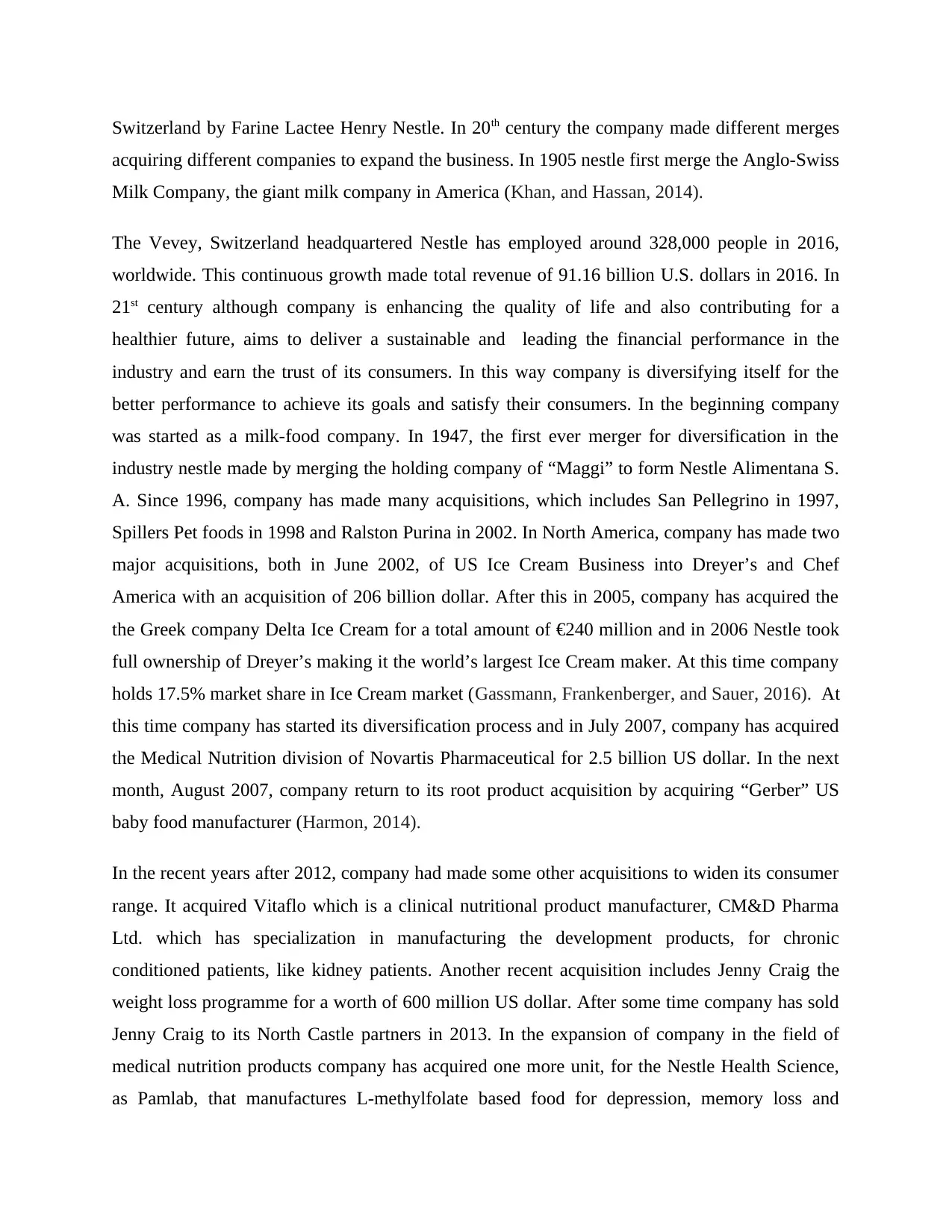
Switzerland by Farine Lactee Henry Nestle. In 20th century the company made different merges
acquiring different companies to expand the business. In 1905 nestle first merge the Anglo-Swiss
Milk Company, the giant milk company in America (Khan, and Hassan, 2014).
The Vevey, Switzerland headquartered Nestle has employed around 328,000 people in 2016,
worldwide. This continuous growth made total revenue of 91.16 billion U.S. dollars in 2016. In
21st century although company is enhancing the quality of life and also contributing for a
healthier future, aims to deliver a sustainable and leading the financial performance in the
industry and earn the trust of its consumers. In this way company is diversifying itself for the
better performance to achieve its goals and satisfy their consumers. In the beginning company
was started as a milk-food company. In 1947, the first ever merger for diversification in the
industry nestle made by merging the holding company of “Maggi” to form Nestle Alimentana S.
A. Since 1996, company has made many acquisitions, which includes San Pellegrino in 1997,
Spillers Pet foods in 1998 and Ralston Purina in 2002. In North America, company has made two
major acquisitions, both in June 2002, of US Ice Cream Business into Dreyer’s and Chef
America with an acquisition of 206 billion dollar. After this in 2005, company has acquired the
the Greek company Delta Ice Cream for a total amount of €240 million and in 2006 Nestle took
full ownership of Dreyer’s making it the world’s largest Ice Cream maker. At this time company
holds 17.5% market share in Ice Cream market (Gassmann, Frankenberger, and Sauer, 2016). At
this time company has started its diversification process and in July 2007, company has acquired
the Medical Nutrition division of Novartis Pharmaceutical for 2.5 billion US dollar. In the next
month, August 2007, company return to its root product acquisition by acquiring “Gerber” US
baby food manufacturer (Harmon, 2014).
In the recent years after 2012, company had made some other acquisitions to widen its consumer
range. It acquired Vitaflo which is a clinical nutritional product manufacturer, CM&D Pharma
Ltd. which has specialization in manufacturing the development products, for chronic
conditioned patients, like kidney patients. Another recent acquisition includes Jenny Craig the
weight loss programme for a worth of 600 million US dollar. After some time company has sold
Jenny Craig to its North Castle partners in 2013. In the expansion of company in the field of
medical nutrition products company has acquired one more unit, for the Nestle Health Science,
as Pamlab, that manufactures L-methylfolate based food for depression, memory loss and
acquiring different companies to expand the business. In 1905 nestle first merge the Anglo-Swiss
Milk Company, the giant milk company in America (Khan, and Hassan, 2014).
The Vevey, Switzerland headquartered Nestle has employed around 328,000 people in 2016,
worldwide. This continuous growth made total revenue of 91.16 billion U.S. dollars in 2016. In
21st century although company is enhancing the quality of life and also contributing for a
healthier future, aims to deliver a sustainable and leading the financial performance in the
industry and earn the trust of its consumers. In this way company is diversifying itself for the
better performance to achieve its goals and satisfy their consumers. In the beginning company
was started as a milk-food company. In 1947, the first ever merger for diversification in the
industry nestle made by merging the holding company of “Maggi” to form Nestle Alimentana S.
A. Since 1996, company has made many acquisitions, which includes San Pellegrino in 1997,
Spillers Pet foods in 1998 and Ralston Purina in 2002. In North America, company has made two
major acquisitions, both in June 2002, of US Ice Cream Business into Dreyer’s and Chef
America with an acquisition of 206 billion dollar. After this in 2005, company has acquired the
the Greek company Delta Ice Cream for a total amount of €240 million and in 2006 Nestle took
full ownership of Dreyer’s making it the world’s largest Ice Cream maker. At this time company
holds 17.5% market share in Ice Cream market (Gassmann, Frankenberger, and Sauer, 2016). At
this time company has started its diversification process and in July 2007, company has acquired
the Medical Nutrition division of Novartis Pharmaceutical for 2.5 billion US dollar. In the next
month, August 2007, company return to its root product acquisition by acquiring “Gerber” US
baby food manufacturer (Harmon, 2014).
In the recent years after 2012, company had made some other acquisitions to widen its consumer
range. It acquired Vitaflo which is a clinical nutritional product manufacturer, CM&D Pharma
Ltd. which has specialization in manufacturing the development products, for chronic
conditioned patients, like kidney patients. Another recent acquisition includes Jenny Craig the
weight loss programme for a worth of 600 million US dollar. After some time company has sold
Jenny Craig to its North Castle partners in 2013. In the expansion of company in the field of
medical nutrition products company has acquired one more unit, for the Nestle Health Science,
as Pamlab, that manufactures L-methylfolate based food for depression, memory loss and
⊘ This is a preview!⊘
Do you want full access?
Subscribe today to unlock all pages.

Trusted by 1+ million students worldwide
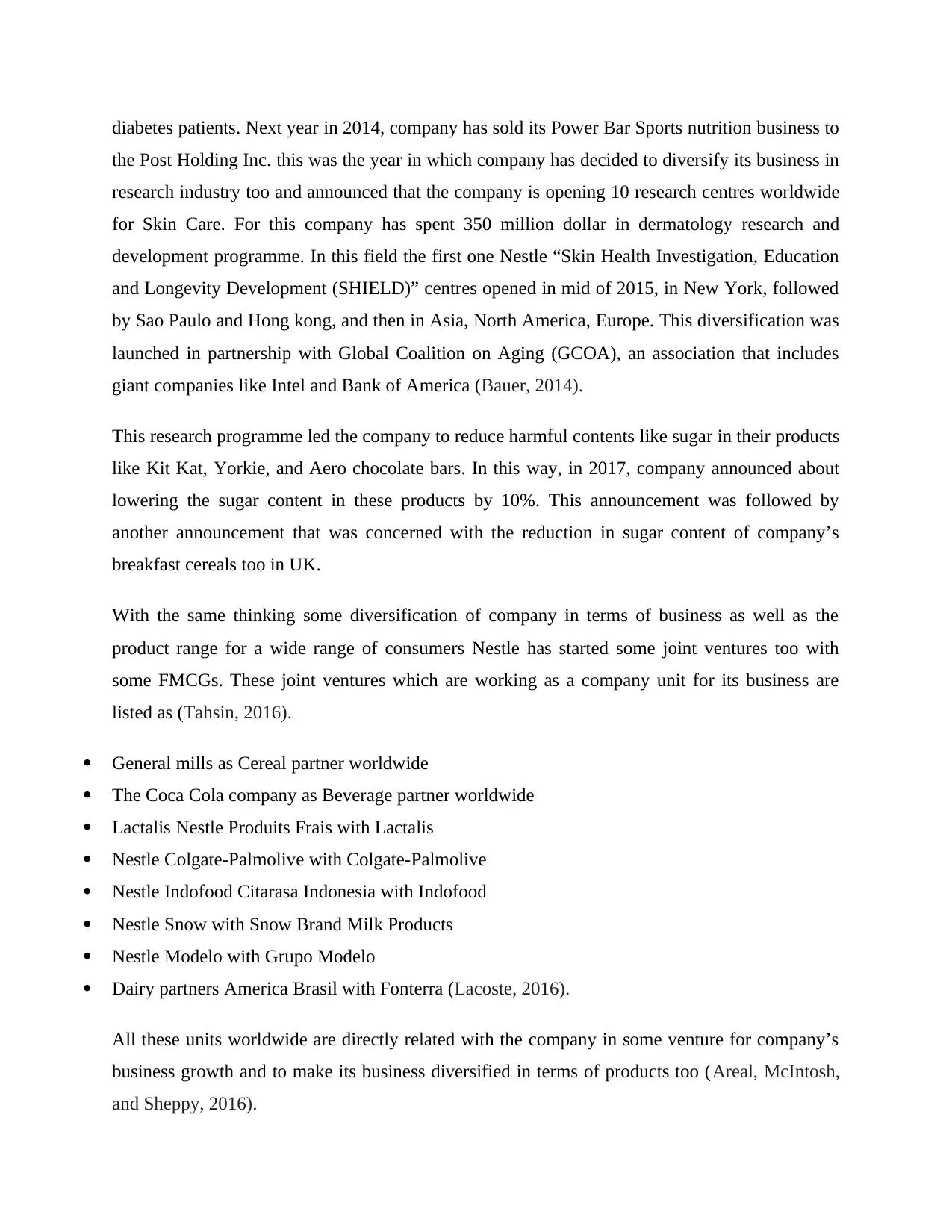
diabetes patients. Next year in 2014, company has sold its Power Bar Sports nutrition business to
the Post Holding Inc. this was the year in which company has decided to diversify its business in
research industry too and announced that the company is opening 10 research centres worldwide
for Skin Care. For this company has spent 350 million dollar in dermatology research and
development programme. In this field the first one Nestle “Skin Health Investigation, Education
and Longevity Development (SHIELD)” centres opened in mid of 2015, in New York, followed
by Sao Paulo and Hong kong, and then in Asia, North America, Europe. This diversification was
launched in partnership with Global Coalition on Aging (GCOA), an association that includes
giant companies like Intel and Bank of America (Bauer, 2014).
This research programme led the company to reduce harmful contents like sugar in their products
like Kit Kat, Yorkie, and Aero chocolate bars. In this way, in 2017, company announced about
lowering the sugar content in these products by 10%. This announcement was followed by
another announcement that was concerned with the reduction in sugar content of company’s
breakfast cereals too in UK.
With the same thinking some diversification of company in terms of business as well as the
product range for a wide range of consumers Nestle has started some joint ventures too with
some FMCGs. These joint ventures which are working as a company unit for its business are
listed as (Tahsin, 2016).
General mills as Cereal partner worldwide
The Coca Cola company as Beverage partner worldwide
Lactalis Nestle Produits Frais with Lactalis
Nestle Colgate-Palmolive with Colgate-Palmolive
Nestle Indofood Citarasa Indonesia with Indofood
Nestle Snow with Snow Brand Milk Products
Nestle Modelo with Grupo Modelo
Dairy partners America Brasil with Fonterra (Lacoste, 2016).
All these units worldwide are directly related with the company in some venture for company’s
business growth and to make its business diversified in terms of products too (Areal, McIntosh,
and Sheppy, 2016).
the Post Holding Inc. this was the year in which company has decided to diversify its business in
research industry too and announced that the company is opening 10 research centres worldwide
for Skin Care. For this company has spent 350 million dollar in dermatology research and
development programme. In this field the first one Nestle “Skin Health Investigation, Education
and Longevity Development (SHIELD)” centres opened in mid of 2015, in New York, followed
by Sao Paulo and Hong kong, and then in Asia, North America, Europe. This diversification was
launched in partnership with Global Coalition on Aging (GCOA), an association that includes
giant companies like Intel and Bank of America (Bauer, 2014).
This research programme led the company to reduce harmful contents like sugar in their products
like Kit Kat, Yorkie, and Aero chocolate bars. In this way, in 2017, company announced about
lowering the sugar content in these products by 10%. This announcement was followed by
another announcement that was concerned with the reduction in sugar content of company’s
breakfast cereals too in UK.
With the same thinking some diversification of company in terms of business as well as the
product range for a wide range of consumers Nestle has started some joint ventures too with
some FMCGs. These joint ventures which are working as a company unit for its business are
listed as (Tahsin, 2016).
General mills as Cereal partner worldwide
The Coca Cola company as Beverage partner worldwide
Lactalis Nestle Produits Frais with Lactalis
Nestle Colgate-Palmolive with Colgate-Palmolive
Nestle Indofood Citarasa Indonesia with Indofood
Nestle Snow with Snow Brand Milk Products
Nestle Modelo with Grupo Modelo
Dairy partners America Brasil with Fonterra (Lacoste, 2016).
All these units worldwide are directly related with the company in some venture for company’s
business growth and to make its business diversified in terms of products too (Areal, McIntosh,
and Sheppy, 2016).
Paraphrase This Document
Need a fresh take? Get an instant paraphrase of this document with our AI Paraphraser
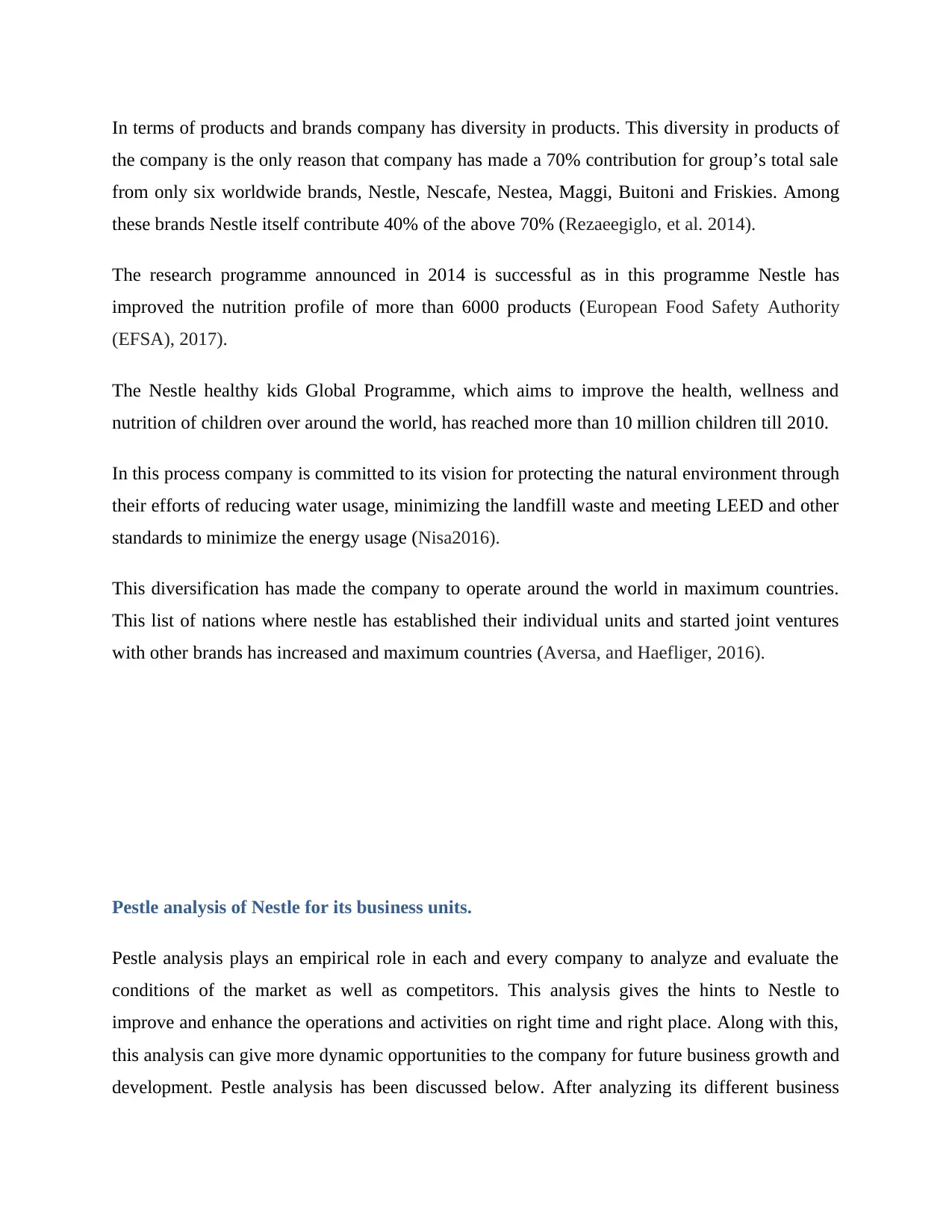
In terms of products and brands company has diversity in products. This diversity in products of
the company is the only reason that company has made a 70% contribution for group’s total sale
from only six worldwide brands, Nestle, Nescafe, Nestea, Maggi, Buitoni and Friskies. Among
these brands Nestle itself contribute 40% of the above 70% (Rezaeegiglo, et al. 2014).
The research programme announced in 2014 is successful as in this programme Nestle has
improved the nutrition profile of more than 6000 products (European Food Safety Authority
(EFSA), 2017).
The Nestle healthy kids Global Programme, which aims to improve the health, wellness and
nutrition of children over around the world, has reached more than 10 million children till 2010.
In this process company is committed to its vision for protecting the natural environment through
their efforts of reducing water usage, minimizing the landfill waste and meeting LEED and other
standards to minimize the energy usage (Nisa2016).
This diversification has made the company to operate around the world in maximum countries.
This list of nations where nestle has established their individual units and started joint ventures
with other brands has increased and maximum countries (Aversa, and Haefliger, 2016).
Pestle analysis of Nestle for its business units.
Pestle analysis plays an empirical role in each and every company to analyze and evaluate the
conditions of the market as well as competitors. This analysis gives the hints to Nestle to
improve and enhance the operations and activities on right time and right place. Along with this,
this analysis can give more dynamic opportunities to the company for future business growth and
development. Pestle analysis has been discussed below. After analyzing its different business
the company is the only reason that company has made a 70% contribution for group’s total sale
from only six worldwide brands, Nestle, Nescafe, Nestea, Maggi, Buitoni and Friskies. Among
these brands Nestle itself contribute 40% of the above 70% (Rezaeegiglo, et al. 2014).
The research programme announced in 2014 is successful as in this programme Nestle has
improved the nutrition profile of more than 6000 products (European Food Safety Authority
(EFSA), 2017).
The Nestle healthy kids Global Programme, which aims to improve the health, wellness and
nutrition of children over around the world, has reached more than 10 million children till 2010.
In this process company is committed to its vision for protecting the natural environment through
their efforts of reducing water usage, minimizing the landfill waste and meeting LEED and other
standards to minimize the energy usage (Nisa2016).
This diversification has made the company to operate around the world in maximum countries.
This list of nations where nestle has established their individual units and started joint ventures
with other brands has increased and maximum countries (Aversa, and Haefliger, 2016).
Pestle analysis of Nestle for its business units.
Pestle analysis plays an empirical role in each and every company to analyze and evaluate the
conditions of the market as well as competitors. This analysis gives the hints to Nestle to
improve and enhance the operations and activities on right time and right place. Along with this,
this analysis can give more dynamic opportunities to the company for future business growth and
development. Pestle analysis has been discussed below. After analyzing its different business
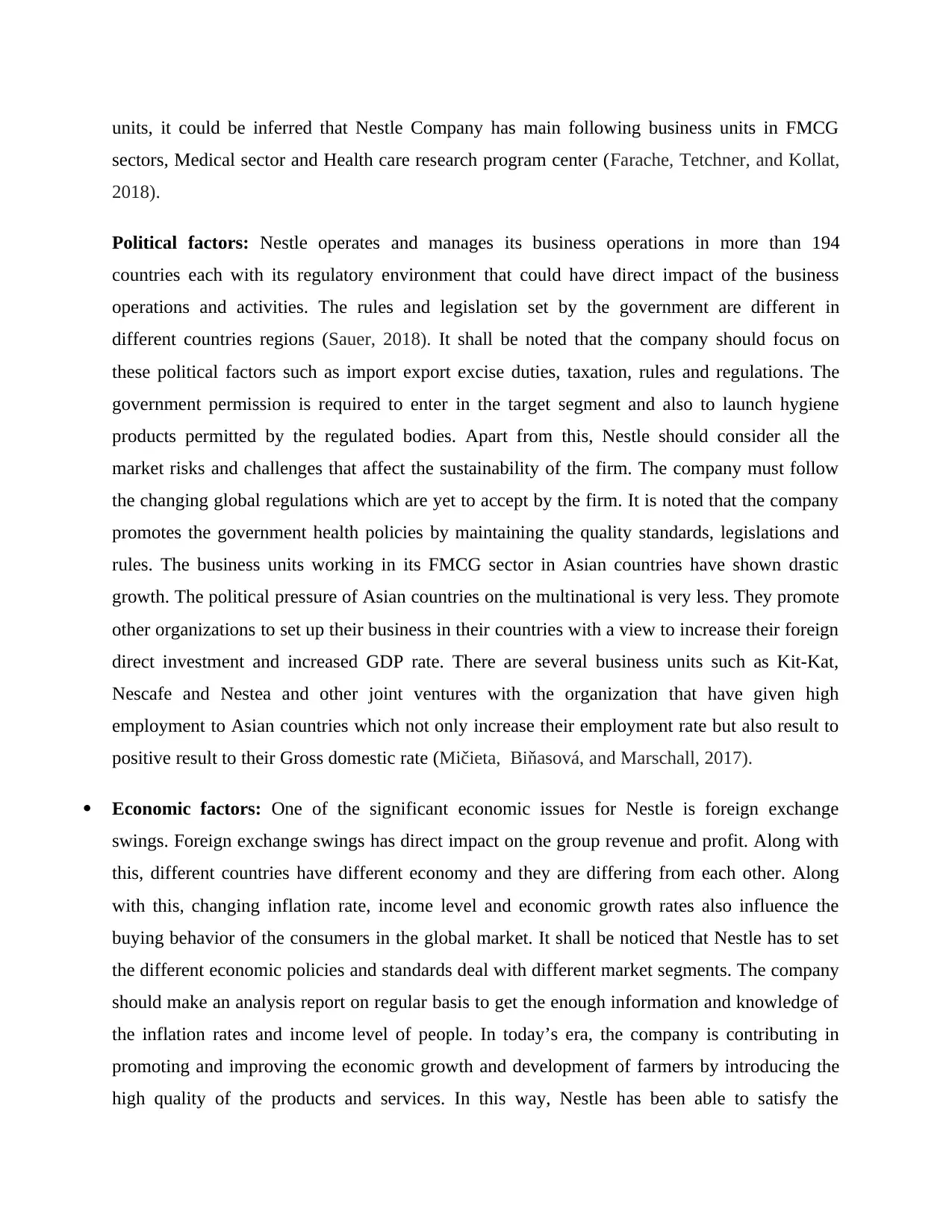
units, it could be inferred that Nestle Company has main following business units in FMCG
sectors, Medical sector and Health care research program center (Farache, Tetchner, and Kollat,
2018).
Political factors: Nestle operates and manages its business operations in more than 194
countries each with its regulatory environment that could have direct impact of the business
operations and activities. The rules and legislation set by the government are different in
different countries regions (Sauer, 2018). It shall be noted that the company should focus on
these political factors such as import export excise duties, taxation, rules and regulations. The
government permission is required to enter in the target segment and also to launch hygiene
products permitted by the regulated bodies. Apart from this, Nestle should consider all the
market risks and challenges that affect the sustainability of the firm. The company must follow
the changing global regulations which are yet to accept by the firm. It is noted that the company
promotes the government health policies by maintaining the quality standards, legislations and
rules. The business units working in its FMCG sector in Asian countries have shown drastic
growth. The political pressure of Asian countries on the multinational is very less. They promote
other organizations to set up their business in their countries with a view to increase their foreign
direct investment and increased GDP rate. There are several business units such as Kit-Kat,
Nescafe and Nestea and other joint ventures with the organization that have given high
employment to Asian countries which not only increase their employment rate but also result to
positive result to their Gross domestic rate (Mičieta, Biňasová, and Marschall, 2017).
Economic factors: One of the significant economic issues for Nestle is foreign exchange
swings. Foreign exchange swings has direct impact on the group revenue and profit. Along with
this, different countries have different economy and they are differing from each other. Along
with this, changing inflation rate, income level and economic growth rates also influence the
buying behavior of the consumers in the global market. It shall be noticed that Nestle has to set
the different economic policies and standards deal with different market segments. The company
should make an analysis report on regular basis to get the enough information and knowledge of
the inflation rates and income level of people. In today’s era, the company is contributing in
promoting and improving the economic growth and development of farmers by introducing the
high quality of the products and services. In this way, Nestle has been able to satisfy the
sectors, Medical sector and Health care research program center (Farache, Tetchner, and Kollat,
2018).
Political factors: Nestle operates and manages its business operations in more than 194
countries each with its regulatory environment that could have direct impact of the business
operations and activities. The rules and legislation set by the government are different in
different countries regions (Sauer, 2018). It shall be noted that the company should focus on
these political factors such as import export excise duties, taxation, rules and regulations. The
government permission is required to enter in the target segment and also to launch hygiene
products permitted by the regulated bodies. Apart from this, Nestle should consider all the
market risks and challenges that affect the sustainability of the firm. The company must follow
the changing global regulations which are yet to accept by the firm. It is noted that the company
promotes the government health policies by maintaining the quality standards, legislations and
rules. The business units working in its FMCG sector in Asian countries have shown drastic
growth. The political pressure of Asian countries on the multinational is very less. They promote
other organizations to set up their business in their countries with a view to increase their foreign
direct investment and increased GDP rate. There are several business units such as Kit-Kat,
Nescafe and Nestea and other joint ventures with the organization that have given high
employment to Asian countries which not only increase their employment rate but also result to
positive result to their Gross domestic rate (Mičieta, Biňasová, and Marschall, 2017).
Economic factors: One of the significant economic issues for Nestle is foreign exchange
swings. Foreign exchange swings has direct impact on the group revenue and profit. Along with
this, different countries have different economy and they are differing from each other. Along
with this, changing inflation rate, income level and economic growth rates also influence the
buying behavior of the consumers in the global market. It shall be noticed that Nestle has to set
the different economic policies and standards deal with different market segments. The company
should make an analysis report on regular basis to get the enough information and knowledge of
the inflation rates and income level of people. In today’s era, the company is contributing in
promoting and improving the economic growth and development of farmers by introducing the
high quality of the products and services. In this way, Nestle has been able to satisfy the
⊘ This is a preview!⊘
Do you want full access?
Subscribe today to unlock all pages.

Trusted by 1+ million students worldwide
1 out of 26
Related Documents
Your All-in-One AI-Powered Toolkit for Academic Success.
+13062052269
info@desklib.com
Available 24*7 on WhatsApp / Email
![[object Object]](/_next/static/media/star-bottom.7253800d.svg)
Unlock your academic potential
Copyright © 2020–2025 A2Z Services. All Rights Reserved. Developed and managed by ZUCOL.





